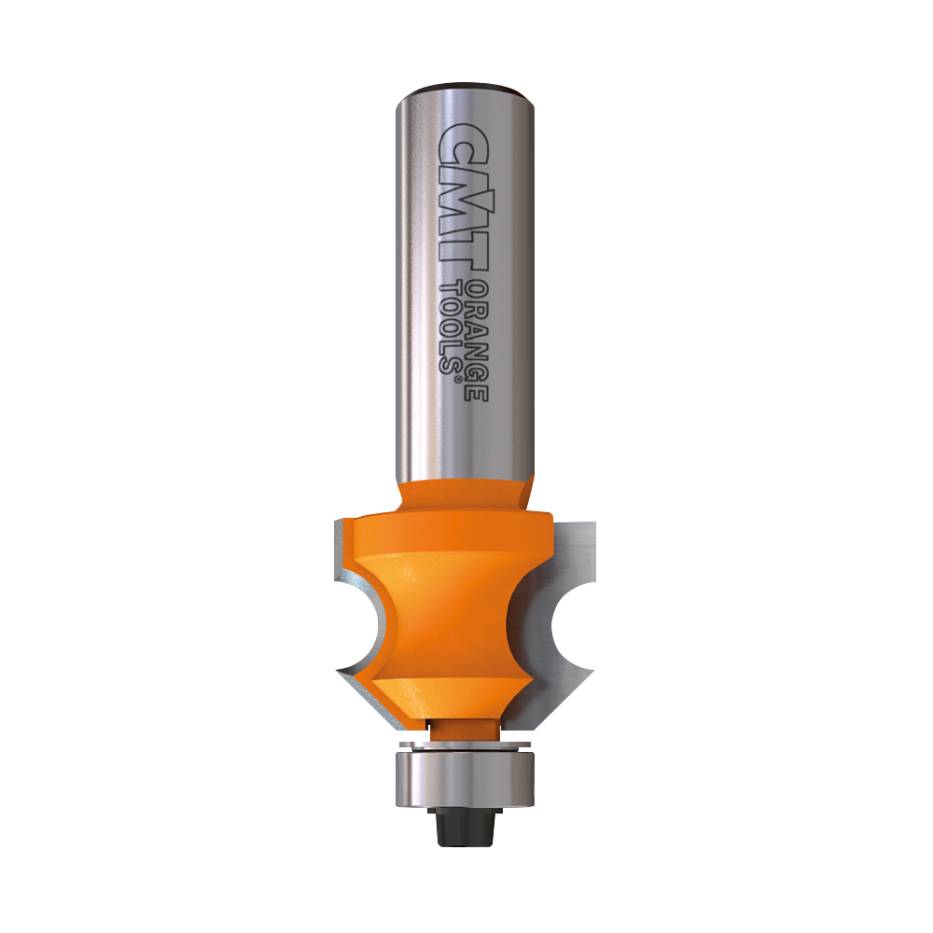Fraise orange
"Très bien, excellent produit"

 | There are many ways to make a back panel for a cabinet. The common denominator is the necessity to allow for seasonal movement, except of course in the case of plywood. Apart from a fully blown raised panel, a common way to make the panel is with shiplapped narrow stock, as shown here. A full tongue and groove lay out offers slightly more stability. This is often combined with a bead along one edge (the one with the tongue) of the individual boards. | |
 | However, the traditional beading bit can only make a straight (“vertical”) cut on the inside of the bead. Only commercially available beaded boards, such as highlighted in this detailed picture, could offer a V-groove on either side of the bead. | |
 | Valfor Tools has developed a novelty design for a single router bit that can do this operation. Leading manufacturer of the famous orange cutting tools CMT have adopted the design. The Wainscot router bit can now be found in the CMT catalogue under reference 861.601.11.For the first time the woodworker can replicate the V-beaded boards that were hitherto only available ready made. | |
 | This is how to make these elegant panels. Just as for the traditional beaded joint, the first operation is to make a tongue & groove on the side of each panel (CMT set 800.626.11). This is the sum total of orange tools required for the Wainscot joint (and a sneak preview of where this is going). | |
 | As always, the tongue & groove bits are set with their ball bearings perfectly flush with the router fence. | |
 | It is important to mark one side of the panels, so that all boards are routed same side up. This will ensure a perfect fit and a flat surface. | |
 | Once the tongue & groove are routed, the Wainscot bit is first used in the lower position to cut the 45˚ chamfer off the groove part. | |
 | Next, the bit is extended to make the bead cut above the tongue. The vertical part of the bit should just touch but not take off any of the tongue’s thickness in order not to disturb its fit. | |
 | This is the resulting panel once all routing has been done. The CMT router bit is unique in being able to do this. | |
 | Here is another look of how this joint fits together. | |
 | Here is a comparison between the panel made with the Wainscot bit, and one where a straight beading bit was used. Which of the two looks better? |
Delivery time: 3 working days
Secure payment:






Disponibile solo su acquisti idonei da 30 EUR a 2.000 EUR. L’idoneità di Paga in 3 rate è soggetta ad approvazione. Consulta il foglio informativo e i termini e le condizioni per maggiori informazioni. Finanziamento con acconto richiesto. Disponibile solo per clienti persone fisiche residenti in Italia. Finanziamento di due mesi. Hai un periodo di 14 giorni per recedere dal tuo finanziamento. Il creditore è PayPal (Europe) S.à rl et Cie, SCA, 22-24 Boulevard Royal, L-2449 Lussemburgo. Un finanziamento è un impegno vincolante che deve essere rimborsato e può influenzare il tuo merito creditizio. Assicurati di essere in grado di ripagare prima di prendere un impegno.
Average rating
(1 commento)|
D Diameter |
I Cutting height |
S Shank diameter |
R Radius |
L Totale length |
Z Number of cutting edges |
a |
Code Code |
Ava. Availability |
Price Price |
Compare Compare |
Wish list Wish list |
Qty Qty |
|---|---|---|---|---|---|---|---|---|---|---|---|---|
| 23,8 | 19,05 | 12,7 | 4 | 68 | 2 | 45° | 861.601.11 |
|
€ 39,77 |
|
||
| 23,8 | 19,05 | 12 | 4 | 68 | 2 | 45° | 961.601.11 |
|
€ 39,77 |
|
| Product |

BEARING D=4.76-12.7mm |

BEARING D=4.76-15.8mm |

SCREW HWEI 1/8WX3/8 |

SHIELD FOR 12,7 mm BEARING |

2,38MM. (3/32") HEX KEY |
|---|---|---|---|---|---|
| 861.601.11 | 791.003.00 | 791.018.00 | 990.058.00 | 990.423.00 | 991.057.00 |
| 961.601.11 | 791.003.00 | 791.018.00 | 990.058.00 | 990.423.00 | 991.057.00 |
Prima
Voldoet geheel aan de verwachting
marinusvannorel
Register now to receive special offer monthly
Average rating
1830 total feedback
Read more feedbacksFraise orange
"Très bien, excellent produit"
Assortment
Quality
Guaranteed price
Fast shipping
Made in Italy






Mobiltecnica S.r.l.
VAT ID 02752210415
Via G. Palatucci, 2 61029 Trasanni di Urbino (PU)
Tel. +39 339 1696947
